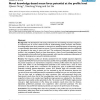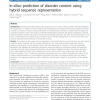148 search results - page 22 / 30 » The evolutionary capacity of protein structures |
BMCBI
2007
13 years 7 months ago
2007
Background: Alternative representations of biochemical networks emphasise different aspects of the data and contribute to the understanding of complex biological systems. In this ...
CANDC
2006
ACM
13 years 7 months ago
2006
ACM
Successful prediction of protein domain boundaries provides valuable information not only for the computational structure prediction of multidomain proteins but also for the exper...
ISMB
2000
13 years 9 months ago
2000
Knowing the number of residue contacts in a protein is crucial for deriving constraints useful in modeling protein folding, protein structure, and/or scoring remote homology searc...
BMCBI
2006
13 years 7 months ago
2006
Background: The development and testing of functions for the modeling of protein energetics is an important part of current research aimed at understanding protein structure and f...
BMCBI
2011
12 years 11 months ago
2011
Background: Intrinsically disordered proteins play important roles in various cellular activities and their prevalence was implicated in a number of human diseases. The knowledge ...


